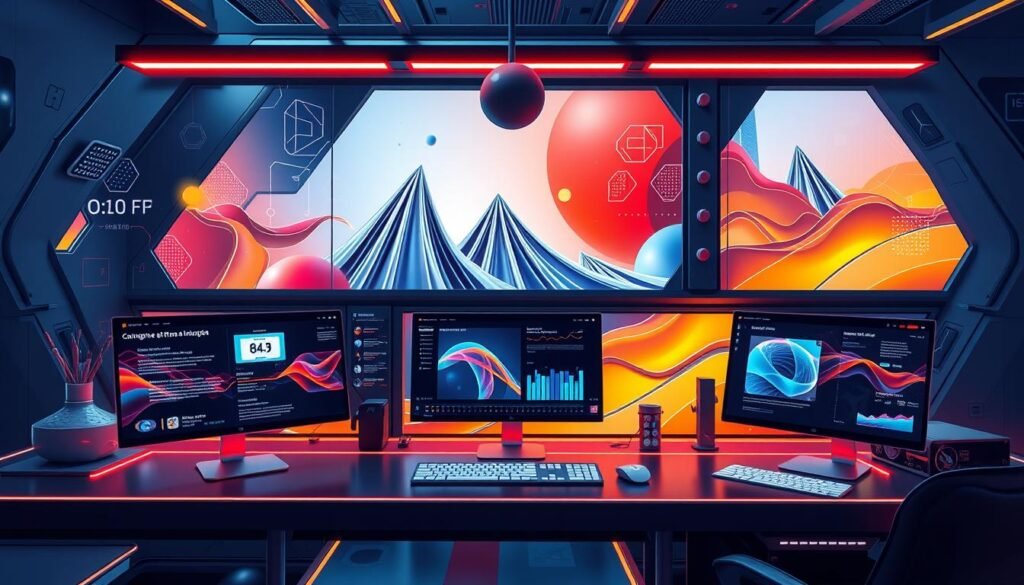
Top 10 Website Design Trends to Boost Engagement and Sales in 2025
A well-designed website is key for businesses to thrive in today’s digital world. It greatly affects how users interact and how sales are made. A site that is both engaging and easy to use can boost sales and revenue. To improve user experience and increase sales, focus on the latest design trends. This way, businesses can stay ahead and meet their goals.

Table of Contents
The Evolution of Web Design: From Past to Present
Web design has changed a lot since the internet started. In the early days, websites were simple and didn’t do much. But, with new tech and digital marketing, web design now focuses on making sites easy to use and fun.
New web design rules, like making sites work on all devices, have been key. Digital marketing also plays a big role. Now, designers make sure websites work well on phones, tablets, and computers.
- Improved accessibility features, enabling users with disabilities to navigate websites more easily
- Enhanced visual elements, such as high-quality images and videos, to capture users’ attention
- Streamlined navigation and intuitive interfaces, facilitating user engagement and conversion
Web design keeps getting better, and it’s important to know the latest trends. Designers and marketers can make websites that not only grab users’ attention but also help businesses grow.
| Web Design Element | Past | Present |
|---|---|---|
| Layout | Basic, fixed-width layouts | Responsive, flexible designs |
| Visuals | Low-quality images and limited graphics | High-quality images, videos, and interactive elements |
| Navigation | Complex, multi-level menus | Streamlined, intuitive interfaces |
AI-Powered Personalization in Website Design
AI is changing how websites talk to users, making experiences fit each person’s likes and actions. It uses smart algorithms and data to make responsive design that meets user needs. This boosts engagement and sales, especially in e-commerce solutions, where personalized tips can lead to more sales.
Some big pluses of AI-powered personalization are:
- It makes user experiences better with content and tips that match their interests.
- It makes marketing more effective by focusing on specific groups of users.
- It helps sell more by suggesting products that fit what users want.
As more businesses use AI for personalization, it’s key to think about responsive design. This ensures a smooth experience on all devices. By combining AI with e-commerce solutions, companies can stay competitive and grow.
Immersive 3D Elements and Virtual Experiences
Immersive 3D elements and virtual experiences are changing how we use websites. By following accessibility guidelines and search engine optimization tips, developers make sites more fun and interactive. This helps a lot of people enjoy their online time.
Developers use WebGL and Three.js to make 3D worlds. This is great for 3D product visualization. It lets users play with products in a real-like way.
Benefits of Immersive 3D Elements
- Enhanced user engagement
- Increased conversion rates
- Improved brand awareness
Implementing Virtual Showrooms and Experience Centers
Virtual showrooms and experience centers are made with 3D modeling, WebGL, and Three.js. They let users dive into products and places in a deep, interactive way. They also help developers learn what users like and do.
| Technology | Benefits |
|---|---|
| WebGL | High-performance 3D rendering |
| Three.js | Easy-to-use JavaScript library for 3D rendering |
Voice User Interface Integration
Technology keeps getting better, and voice user interface integration is a big part of that. It lets users talk to websites instead of typing. This change will shape how websites look and work in the future.
Some good things about voice UI include:
- Improved user experience
- Increased accessibility
- Enhanced engagement
But, there are also some challenges. For example, making sure the voice commands are understood correctly. Also, websites need to work well with voice commands.
Web designers should add voice UI to their designs. This will make websites easier to use and more fun. It will also make websites work better for everyone.

As more people use voice assistants, web designers need to focus on voice-based interactions. This will make websites better for everyone.
Micro-Interactions and Motion Design
Micro-interactions and motion design are key to a great website user experience. They add subtle animations and interactive parts. This makes the site more engaging and encourages users to explore more.
Good micro-interactions can really improve how users feel about a site. For instance, a small animation that shows a button click can give feedback. It makes the site feel more alive and responsive.
Strategic Animation Implementation
Using animations wisely is important. They should make the site better, not clutter it. A smart approach to animations can make the site more engaging and help with sales.
Performance-Optimized Motion Effects
Smooth animations are crucial for a good user experience. Optimizing motion effects prevents delays and lag. This keeps the site running smoothly and helps with sales.
User Engagement Through Interactive Elements
Interactive parts like hover effects and scrolling animations boost engagement. Using them well can make the site more enjoyable. This helps users stay longer and increases sales.
Top 10 Website Design Trends to Boost Engagement and Sales in 2025
Exploring web design, it’s key to know the latest trends for better engagement and sales. Web design principles are vital for a site that’s easy to use and looks great. By using the newest design trends, businesses can lead the pack and grow their online presence.
In today’s digital world, digital marketing is crucial for any business. A well-made website can help reach the target audience and boost sales. Here are the top 10 website design trends for 2025:
- Mobile-first design
- Immersive 3D elements
- Voice user interface integration
- Micro-interactions and motion design
- Sustainable and eco-friendly design principles
- Advanced mobile-first architectures
- Privacy-focused design elements
- Augmented reality integration
- AI-powered personalization
- Virtual and augmented reality experiences
By using these trends, businesses can make a website that’s engaging and boosts sales. It’s important to keep up with the latest web design principles and digital marketing to stay competitive.

By embracing these trends and design principles, businesses can make a website that looks good and works well. This will drive sales and increase engagement.
| Trend | Description |
|---|---|
| Mobile-first design | Designing for mobile devices first to ensure a seamless user experience |
| Immersive 3D elements | Using 3D elements to create an immersive and engaging user experience |
| Voice user interface integration | Integrating voice user interface to provide a hands-free user experience |
Sustainable and Eco-Friendly Design Principles
The world is getting greener, and so is website design. Eco-friendly design is good for the planet and makes websites better for users. It also makes businesses look more trustworthy. Websites that are easy to use on any device can help save energy and reduce waste.
Here are some ways to make websites more eco-friendly:
- Optimizing images and videos to reduce file size and data transfer
- Using energy-efficient coding practices and minimizing server requests
- Implementing green hosting solutions that utilize renewable energy sources
By using these methods, businesses can help the environment and make websites faster and more enjoyable. As people care more about the planet, businesses that focus on green design will win their trust and loyalty.
Green design is also key for e-commerce sites. It makes online stores look good and be good for the planet. By focusing on responsive design and making websites run smoothly, businesses can help the environment and build a better future.
| Design Principle | Benefits |
|---|---|
| Green Hosting Solutions | Reduced carbon footprint, improved website performance |
| Energy-Efficient Design Practices | Minimized energy consumption, enhanced user experience |
| Carbon Footprint Reduction Strategies | Improved brand credibility, increased customer loyalty |
Advanced Mobile-First Architectures
In today’s fast-changing world of website design, making sure your site is accessible on all devices is key. Advanced mobile-first designs help make websites that work well on phones and tablets. This not only makes users happy but also helps your site rank better in search engines.
Mobile-first design makes building websites easier. It starts with the most important parts of a site, then adds more for bigger screens. This way, designers can make sure their site works for everyone, no matter what device they use.
Here are some tips for creating advanced mobile-first designs:
- Use responsive design for a layout that works on any screen size.
- Focus on the most important content and features for a smooth user experience.
- Make sure images and media load quickly to keep your site fast.
- Test your site on all devices to make sure it works everywhere.
By following these tips and focusing on search engine optimization, designers can make mobile-first sites that are great for users and search engines. As the digital world keeps changing, staying ahead with mobile-first design is essential to stay competitive.
Privacy-Focused Design Elements
Website design trends are changing, with a big focus on user privacy. This is key for building trust and following rules like GDPR. A good website design boosts performance and protects user data.
It’s important to add privacy-focused design elements to make websites secure and trustworthy. This means following GDPR, protecting user data, and making privacy controls clear.
GDPR Compliance Integration
GDPR compliance is vital for privacy-focused design. Websites need to meet GDPR standards for protecting user data. This includes getting consent, sharing clear privacy policies, and using data protection measures.
User Data Protection Features
User data protection features are key for gaining user trust. These include encryption, secure storage, and access controls. With these, websites can keep user data safe and secure.
Transparent Privacy Controls
Transparent privacy controls give users clear info on data use. This means easy-to-understand privacy policies, options to opt-out, and clear data access instructions.
By adding these privacy-focused design elements, websites can improve performance, gain user trust, and follow the latest design trends.
Augmented Reality Integration
Augmented reality (AR) is becoming more popular in website design. It offers new ways to make websites more interactive and immersive. By adding AR elements, websites can make the user experience more engaging and memorable.
AR can also help improve conversion rate optimization. It makes websites more immersive, which can lead to more conversions. This could be buying something, filling out a form, or engaging with content.
- Using AR to showcase products in a more interactive way
- Creating immersive experiences that simulate real-world environments
- Using AR to provide interactive tutorials or guides
By using AR in website design, businesses can stay ahead. They offer a unique user experience that stands out from others. As technology keeps improving, we’ll see even more creative uses of AR in websites. This will lead to better conversion rate optimization and more user engagement.
Conclusion: Implementing Future-Ready Design Strategies
In today’s fast-changing world of website design, it’s key for businesses to stay ahead. The web design principles and trends we’ve discussed offer a clear path. They help create websites that are not just good-looking but also effective in digital marketing.
Using the latest tech, like AI and 3D, web designers can make websites that really stand out. They can also focus on making websites that are good for the planet and protect user privacy. This shows a brand cares about the environment and its customers.
To succeed online, businesses need to think ahead and keep their web design principles up to date. By doing this, they can meet their customers’ changing needs. This way, they can stay successful for a long time and lead in their fields.
FAQ
What are the top 10 website design trends to boost engagement and sales in 2025?
In 2025, top website design trends will focus on making sites more engaging and user-friendly. They aim to boost sales and revenue. Trends include AI-powered personalization, immersive 3D elements, and virtual experiences. Also, voice user interface integration, micro-interactions, and sustainable design principles are key.
How has the evolution of web design been shaped by technological advancements and changes in user behavior?
Web design has evolved due to tech advancements and user behavior changes. The rise of mobile devices and AI have been major factors. Changes in user preferences have also driven the evolution, leading to more responsive and personalized sites.
What are the benefits of AI-powered personalization in website design?
AI personalization in website design offers tailored experiences based on user preferences. It uses machine learning to deliver content and product recommendations. This enhances user engagement and drives sales.
How can websites integrate immersive 3D elements and virtual experiences?
Websites can use WebGL and Three.js to add immersive 3D elements. This includes 3D product visualization and virtual showrooms. It provides users with engaging digital experiences.
What are the advantages of voice user interface integration in website design?
Voice user interface integration makes websites more accessible and user-friendly. It allows users to interact with sites using voice commands. This improves website performance, especially in e-commerce and mobile design.
How can micro-interactions and motion design improve user engagement?
Micro-interactions and motion design are crucial for modern websites. They enhance user engagement and experience. By using animations and interactive elements, websites can offer more immersive experiences.
What are the key principles of sustainable and eco-friendly website design?
Sustainable website design focuses on green hosting and energy-efficient practices. It aims to reduce carbon footprint. This approach creates websites that are good for the planet and the user.
How can websites implement advanced mobile-first architectures?
Advanced mobile-first architectures ensure websites work well on mobile devices. They use responsive design and mobile-specific features. This prioritizes mobile accessibility and performance.
What privacy-focused design elements should be integrated into website design?
Privacy-focused design includes GDPR compliance and user data protection. It also involves transparent privacy controls. These elements build trust and ensure compliance with data privacy regulations.
How can augmented reality be integrated into website design?
Augmented reality in website design offers interactive and immersive experiences. It enhances product visualization and provides virtual try-on experiences. This improves user engagement and conversion rates.



Хороший опыт сотрудничества, сопровождение импорта организовано профессионально https://vsoprovozhdenie.ru/
Официальный сайт Kraken https://kra44-cc.at безопасная платформа для анонимных операций в darknet. Полный доступ к рынку через актуальные зеркала и onion ссылки.
Fabet Snowsell, ok, sounds interesting and unique, is it trustworthy? See for yourself: fabetsnowsell